PRL-3 promotes telomere deprotection and chromosomal instability
- PMID: 28482095
- PMCID: PMC5499835
- DOI: 10.1093/nar/gkx392
PRL-3 promotes telomere deprotection and chromosomal instability
Abstract
Phosphatase of regenerating liver (PRL-3) promotes cell invasiveness, but its role in genomic integrity remains unknown. We report here that shelterin component RAP1 mediates association between PRL-3 and TRF2. In addition, TRF2 and RAP1 assist recruitment of PRL-3 to telomeric DNA. Silencing of PRL-3 in colon cancer cells does not affect telomere integrity or chromosomal stability, but induces reactive oxygen species-dependent DNA damage response and senescence. However, overexpression of PRL-3 in colon cancer cells and primary fibroblasts promotes structural abnormalities of telomeres, telomere deprotection, DNA damage response, chromosomal instability and senescence. Furthermore, PRL-3 dissociates RAP1 and TRF2 from telomeric DNA in vitro and in cells. PRL-3-promoted telomere deprotection, DNA damage response and senescence are counteracted by disruption of PRL-3-RAP1 complex or expression of ectopic TRF2. Examination of clinical samples showed that PRL-3 status positively correlates with telomere deprotection and senescence. PRL-3 transgenic mice exhibit hallmarks of telomere deprotection and senescence and are susceptible to dextran sodium sulfate-induced colon malignancy. Our results uncover a novel role of PRL-3 in tumor development through its adverse impact on telomere homeostasis.
© The Author(s) 2017. Published by Oxford University Press on behalf of Nucleic Acids Research.
Figures
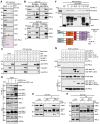

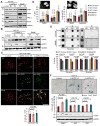
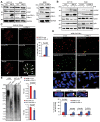


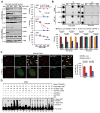

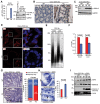
Similar articles
-
POT1 and TRF2 cooperate to maintain telomeric integrity.Mol Cell Biol. 2005 Feb;25(3):1070-80. doi: 10.1128/MCB.25.3.1070-1080.2005. Mol Cell Biol. 2005. PMID: 15657433 Free PMC article.
-
An H2A Histone Isotype, H2ac, Associates with Telomere and Maintains Telomere Integrity.PLoS One. 2016 May 26;11(5):e0156378. doi: 10.1371/journal.pone.0156378. eCollection 2016. PLoS One. 2016. PMID: 27228173 Free PMC article.
-
PRL-3 activates NF-κB signaling pathway by interacting with RAP1.Biochem Biophys Res Commun. 2013 Jan 4;430(1):196-201. doi: 10.1016/j.bbrc.2012.11.036. Epub 2012 Nov 21. Biochem Biophys Res Commun. 2013. PMID: 23178297
-
Abnormal function of telomere protein TRF2 induces cell mutation and the effects of environmental tumor‑promoting factors (Review).Oncol Rep. 2021 Aug;46(2):184. doi: 10.3892/or.2021.8135. Epub 2021 Jul 19. Oncol Rep. 2021. PMID: 34278498 Free PMC article. Review.
-
Role of Rap1 in DNA damage response: implications in stem cell homeostasis and cancer.Exp Hematol. 2020 Oct;90:12-17. doi: 10.1016/j.exphem.2020.08.009. Epub 2020 Aug 26. Exp Hematol. 2020. PMID: 32858091 Review.
Cited by
-
Knockdown of PRL-3 increases mitochondrial superoxide anion production through transcriptional regulation of RAP1.Cancer Manag Res. 2018 Oct 30;10:5071-5081. doi: 10.2147/CMAR.S165344. eCollection 2018. Cancer Manag Res. 2018. PMID: 30464607 Free PMC article.
-
Combination of ERK2 and STAT3 Inhibitors Promotes Anticancer Effects on Acute Lymphoblastic Leukemia Cells.Cancer Genomics Proteomics. 2020 Sep-Oct;17(5):517-527. doi: 10.21873/cgp.20208. Cancer Genomics Proteomics. 2020. PMID: 32859630 Free PMC article.
-
Integrated Genome-Wide Analysis of Gene Expression and DNA Copy Number Variations Highlights Stem Cell-Related Pathways in Small Cell Esophageal Carcinoma.Stem Cells Int. 2018 Aug 30;2018:3481783. doi: 10.1155/2018/3481783. eCollection 2018. Stem Cells Int. 2018. PMID: 30228821 Free PMC article.
-
A loss-of-function genetic screening reveals synergistic targeting of AKT/mTOR and WTN/β-catenin pathways for treatment of AML with high PRL-3 phosphatase.J Hematol Oncol. 2018 Mar 7;11(1):36. doi: 10.1186/s13045-018-0581-9. J Hematol Oncol. 2018. PMID: 29514683 Free PMC article.
-
PTP4A3 Is a Prognostic Biomarker Correlated With Immune Infiltrates in Papillary Renal Cell Carcinoma.Front Immunol. 2021 Sep 23;12:717688. doi: 10.3389/fimmu.2021.717688. eCollection 2021. Front Immunol. 2021. PMID: 34630392 Free PMC article.
References
-
- Al-Aidaroos A.Q., Zeng Q.. PRL-3 phosphatase and cancer metastasis. J. Cell. Biochem. 2010; 111:1087–1098. - PubMed
-
- Bessette D.C., Qiu D., Pallen C.J.. PRL PTPs: mediators and markers of cancer progression. Cancer Metastasis. Rev. 2008; 27:231–252. - PubMed
-
- Rios P., Li X., Köhn M.. Molecular mechanisms of the PRL phosphatases. FEBS J. 2013; 280:505–524. - PubMed
-
- Achiwa H., Lazo J.S.. PRL-1 tyrosine phosphatase regulates c-Src levels, adherence, and invasion in human lung cancer cells. Cancer Res. 2007; 67:643–650. - PubMed
-
- Hardy S., Wong N.N., Muller W.J., Park M., Tremblay M.L.. Overexpression of the protein tyrosine phosphatase PRL-2 correlates with breast tumor formation and progression. Cancer Res. 2010; 70:8959–8967. - PubMed
MeSH terms
Substances
LinkOut - more resources
Full Text Sources
Other Literature Sources
Molecular Biology Databases
Research Materials
Miscellaneous

